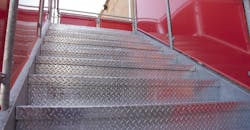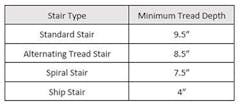How to Choose the Best Stair for Your Application
Determining when and where to use different types of stairs can be tricky. Different codes address applicable uses with different levels of specificity. For instance, IBC gives clear use-cases for the alternating tread stair, while OSHA gives performance-based guidance leaving employers more flexibility to decide for themselves.
OSHA-Compliant
In 2017, OSHA revised its standards on walking surfaces with the goal of preventing and reducing slips, trips, and falls. With the new rule, OSHA for the first time directly addressed the use of alternating tread stairs in the main body of its standards. The new rule also changed the standards on standard stairs, ship stairs, spiral stairs, ladders, and fall protection requirements.
In section 1910.25(b)(8) of the new standard, OSHA provides the use-case guideline that "Spiral, ship, or alternating tread-type stairs are used only when the employer can demonstrate that it is not feasible to provide standard stairs." OSHA believes this performance-based guideline provides greater flexibility to employers to determine the feasibility of use versus limiting use to more specifically defined circumstances.
OSHA also introduced to its standards the concepts of maximum riser heights and minimum tread depths to make it consistent with IBC and NFPA standards. The minimum tread depths differ for each stair type with the understanding that each type has inherently different climbing techniques, use-cases, and risks associated with use. The following is a summary of the new OSHA tread depth requirements:
While less than the 11” tread depth required by IBC, OSHA believes that 9.5” tread depth is adequate stepping space for standard stairs. OSHA further reasons that tread depths less than 9.5,” while not ideal, can still be safely permitted for applications where standard stairs are not feasible.
IBC-Compliant
In contrast with OSHA’s performance-based guidelines, IBC provides specific use-cases for stair types and leaves little room for interpretation. For example, IBC addresses the alternating tread stair as a means of egress (a path of vertical and horizontal travel from any occupied portion of a building or structure to a public way). IBC allows for the following cases for use of the alternating tread stair:
- To mezzanines less than 250 square feet in area and serving five occupants or less in a building whose occupancy is F, H or S. (1009.10)
- To prison guard towers, control rooms or observation decks less than 250 square feet in area (1009.10)
- To unoccupied roofs. (1009.12)
- As one of two means of egress to boiler rooms, incinerator rooms, furnace rooms or refrigeration machinery rooms. (1014.3,4)
- To stage catwalks, galleries, and gridirons leading to a floor or roof (1014.6.1)
- Alternating tread stairs are also permitted for access to equipment platforms as a non-means of egress (505)
Safety-Focused Design
To reduce the chance of a slip or fall, opt for the maximum tread depth possible to provide the greatest stepping surface for users. Use the OSHA tread depth requirements and start with the option that provides the most tread depth and determines if it is feasible for your application. If not, move to the next option and continue until you determine which type of stair will provide the most tread depth while also meeting the other requirements of your application. You should only consider using a ladder if none of the stair options will fit.
Making your choice based on tread depth is a simple concept and an easy way to maximize the safety and comfort of users. You can eliminate any guesswork and be confident you have chosen the best option for your application.
About the Author
Lapeyre Stair
More than 85,000 Lapeyre Stair alternating tread stairs are in use around the world today, allowing workers to easily and safely access crossovers, catwalks, and other tight spots that do not permit the use of conventional staircases.
At the company's headquarters outside of New Orleans, Louisiana, alternating tread stairs and traditional steel stairs are manufactured to meet specific height and building code requirements. A variety of options and additional products integrate to create complete, custom stair systems design for each, individual customer's specifications.
Alternating tread stairs can be ordered online and ship within 15 business days. Pre-engineered steel stairs are designed upon approval and ship directly to the project site, ready for installation.
As a dedicated stair manufacturer, Lapeyre Stair provides a complete outsource solution that allows customers to focus on higher priority aspects of their projects.




